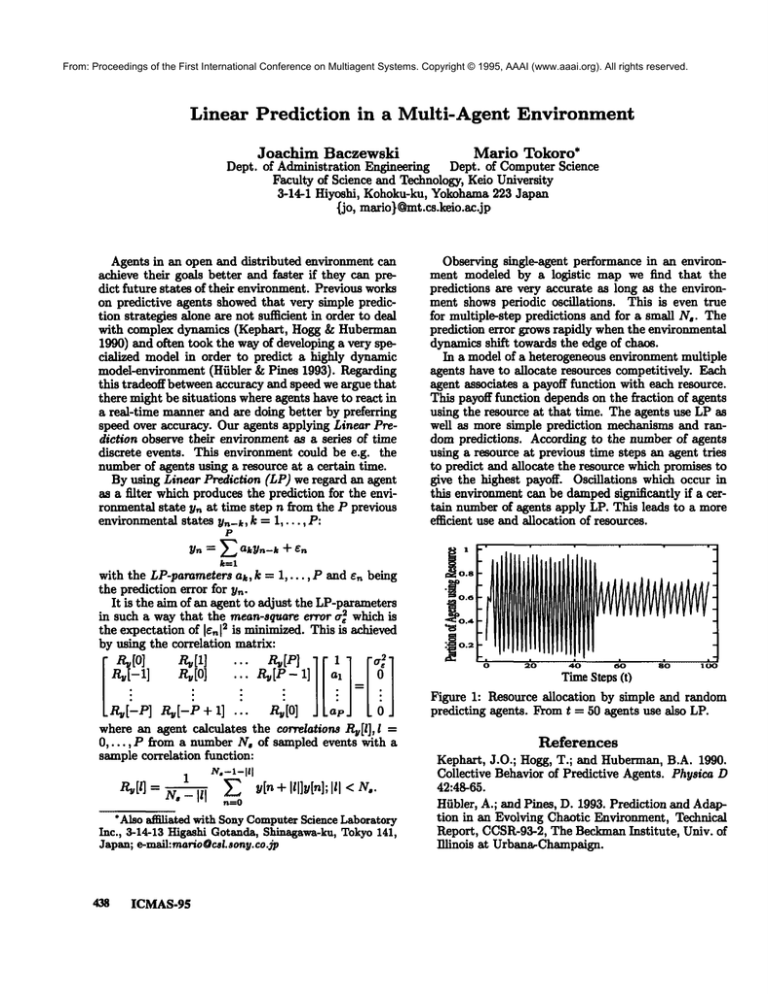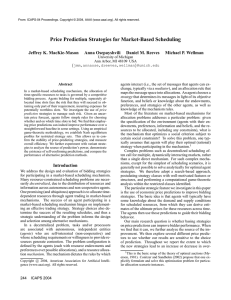
From: Proceedings of the First International Conference on Multiagent Systems. Copyright © 1995, AAAI (www.aaai.org). All rights reserved.
Linear Prediction
in a Multi-Agent
Joachim Baczewski
Environment
Mario Tokoro*
Dept. of Administration Engineering Dept. of Computer Science
Faculty of Science and Technology, Keio University
3-14-1 Hiyoshi, Kohoku-ku, Yokohama223 Japan
{jo, mario}~mt.cs.lmio.ac.j p
Agents in an open and distributed environment can
achieve their goals better and faster if they can predict future states of their environment. Previous works
on predictive agents showed that very simple prediction strategies alone are not sufficient in order to deal
with complex dynamics (Kephart, Hogg & Huberman
1990) and often took the way of developing a very specialized model in order to predict a highly dynamic
model-environment (Hiibler & Pines 1993). Regarding
this tradeoif between accuracy and speed we argue that
there might be situations where agents have to react in
a real-time manner and are doing better by preferring
speed over accuracy. Our agents applying Linear Prediction observe their environment as a series of time
discrete events. This environment could be e.g. the
number of agents using a resource at a certain time.
By using Linear Prediction (LP) we regard an agent
as a filter which produces the prediction for the environmental state yn at time step n from the P previous
environmental states yn-k, k = 1,..., P:
P
Yn = ~_~ akyn--h
Observing singie-agent performance in an environment modeled by a logistic
map we find that the
predictions are very accurate as long as the environment shows periodic oscillations.
This is even true
for multiple-step predictions and for a small ]Vs. The
prediction error grows rapidly when the environmental
dynamics shift towards the edge of chaos.
In a model of a heterogeneous environment multiple
agents have to allocate resources competitively. Each
agent associates a payoff function with each resource.
This payoff function depends on the fraction of agents
using the resource at that time. The agents use LP as
well as more simple prediction mechanisms and random predictions. According to the number of agents
using a resource at previous time steps an agent tries
to predict and allocate the resource which promises to
give the highest payoff. OsciUations which occur in
this environment can be dampedsignificantly if a certain number of agents apply LP. This leads to a more
efficient use and allocation of resources.
"~ en
kffil
with the LP-parameters ah, k = 1,..., P and e~ being
the prediction error for y~.
It is the aim of an agent to adjust the LP-parameters
in such a way that the mean-square error ~ which is
the expectation of [~, [2 is minimized. This is achieved
by using the correlation matrix:
]
:
R,[0]
P [P- 11
¯
.
:
al _ 0
:
--
:
LR~[’-P]P~[-P
+ 1] ... R,[O] La~,JL ()
where an agent calculates the correlations Rv[l], i =
0,...,
P from a number N, of sampled events with a
sample correlation function:
1 Jv.-*-IZl
P~[I] = No - Ill ~
y[n + Ill]y[n]; Ill < No.
n~-0
¯ Also atrdiated with Sony ComputerScience Laboratory
Inc., 3-14-13 Higashi Gotanda, Shinagawa-ku, Tokyo141,
Japan; e-mail:mario@csl.sony.co.jp
4~
ICMAS-g$
2’0
4’o
~
TimeSteps (0
8’o
1~o
Figure1: Resource allocation by simple and random
predicting agents. From t = 50 agents use also LP.
References
Kephart,
J.O.;Hogg,T.; and Huberman,
B.A.1990.
Collective
Behavior
of Predictive
Agents.
Physica
D
42:48-65.
Hfibler,
A.;andPines,
D. 1993.Prediction
andAdaptionin an Evolving
ChaoticEnvironment,
Technical
Report,CCSR-93-2,
TheBeckmanInstitute,
Univ.of
nlinoisat Urbana~Champalgn.







